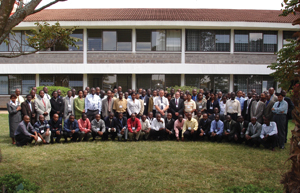|
|
Vol.
29 No. 3
May-June 2007
 Occupational
Health and Safety Management in East Africa Occupational
Health and Safety Management in East Africa
by Kelvin Khisa
A three-day regional conference on Occupational
Health and Safety Management in East Africa was
held in Nairobi, Kenya, from 27–29 September 2006. It
attracted over 120 participants, drawn mainly from industry,
the service sector (hotels and hospitals), business associations,
consultancy, NGOs, and academia.
This conference was sponsored by IUPAC, which provided some
financial support. The IUPAC Committee on Chemistry and Industry
(COCI) endorsed the event and Mark Cesa, COCI chairman, participated
in the conference.
The conference featured 30 presentations by health and safety
practitioners drawn from the UK, USA, Uganda, and Kenya. The
well-attended conference also had two exhibitions by SGS and
Bureau Veritas Quality International, two companies that provide
certification services in health and safety management.
In recent years there has been increased emphasis in East Africa
on the need to improve occupational health and safety (OH&S)
in response to a marked increase in the number of work-related
accidents. Public awareness of these accidents has provided
a driving force for industry and allied activities to improve
on their safety records. Local and national governments and
the insurance industry are taking a hard look at safety in industry
as a whole and the chemical industry in particular, and there
has been a great increase in the amount of government regulation
in this area. It is against this background that the conference
was organized.
The
conference aimed to enable industrialists and other stakeholders
to appreciate the purpose of an OH&S management system,
explain its enabling legal and regulatory framework, and explore
the purpose and intent of OH&S Assessment Series (OHSAS)
18001/2. It was concluded that measures to improve health
and safety should first eliminate hazards where practicable,
then reduce risks as a second choice, and then mandate the
use of personal protective equipment (PPEs) as a last resort.

Participants
in the Regional Conference on Occupational Health and Safety
Management in East Africa that was held in Nairobi, Kenya,
from 27–29 September 2006.
Whereas
industry in developed countries often takes OH&S issues
very seriously, their counterparts in the developing world
do not do so. This is largely due to lack of awareness, non-enforcement
of relevant safety laws and regulations, and a lack of a systematic
structure that guides the establishment of sound OH&S
management systems. The end result has been an uncoordinated
approach to safety issues, a development that exposes workers
to high levels of risks and hazards.
Although hazard elimination is the goal, experience has taught
us that guaranteed, failure-free designs and devices have
so far eluded mankind, despite his astonishing advances in
knowledge and technology. Certainly all of us in our personal
experiences have had many opportunities to reconfirm the wisdom
of the admonition, “Plan for the best, but prepare for
the worst.” There is therefore an urgent need for developing
country industrialists and key stakeholders to be exposed
to OHSAS specifications that give requirements for an OH&S
management system and enables organizations to control their
full range of risks and hazards.
The presented papers covered a wide range of topics such as
IUPAC’s role in helping chemical industry contribute
to sustainable development, wealth creation and the improvement
of quality of life; the OHSAS certification process; the legal
and regulatory framework for OH&S; OHSAS as a tool for
enhancing industrial competitiveness; health and safety policy
statements; accidents and first aid; the role of cleaner production
in occupational health and safety management; responsible
care in chemical production; hazard identification in chemical
production; risk assessments in chemical production; systematic
safety, health, and environment reviews; noise management
in the work environment; and classification and labeling of
hazardous substances. Additional presentations included Home
Grown Solutions to Health and Safety Management; Fire Emergency
Preparedness and Response; Management of Asbestos Materials;
Material Safety Data Sheets; Work Place Safety and Welfare;
Benefits of Acquiring OHSAS Certification: The GlaxoSmithKline
Experience; Electrical Safety; and the Role of PPEs in Occupational
Health and Safety Management.
The participation of Kenya and Uganda enabled the participants
to share experiences and lessons learnt within the framework
of the provisions of their respective legal and regulatory
regimes. Video presentations during the conference from the
UK helped conference participants to visibly appreciate the
importance of having a functional OH&S system.
The conference also allowed for group discussions on following
OH&S issues: institutional and enforcement frameworks;
legal, regulatory, and policy regimes; emergency preparedness
and response; technological shortcomings; capacity building;
and research and development. It was unanimously agreed that
there is a need for follow up activities after the execution
of health and safety audits in selected companies in Uganda
and Kenya. Specifically, these companies need help developing
performance indicators that will guide the long term monitoring
and evaluation program. Logistical arrangements that will
enable the realization of this goal are underway.
The main sponsors of this conference were IUPAC and the United
Nations Educational, Scientific and Cultural Organization,
which works as a laboratory of ideas and a standard setter
for the purposes of forging universal agreements on emerging
ethical issues. The success of the conference demonstrates
the emerging importance of public-private sector partnerships
in the promotion of occupational health and safety issues
in the region.
The next step is to embark on actual health and safety audits
in Uganda and Kenya, once the logistical arrangements are
finalized. This will be completed as part of IUPAC project
<www.iupac.org/projects/2005/2005-046-1-022.html>.
Kelvin
Khisa <[email protected]>
was the conference organizer for this meeting. He is currently
a deputy director at the Kenya National Cleaner Production
Center in Nairobi. In August 2002, Kelvin Khisa was a fellow
of the COCI Safety Training Program. His training included
a visit to Sankyo Co., Ltd. production and research facilities
in Japan.
Page
last modified 15 June 2007.
Copyright © 2003-2007 International Union of Pure and
Applied Chemistry.
Questions regarding the website, please contact [email protected]
|